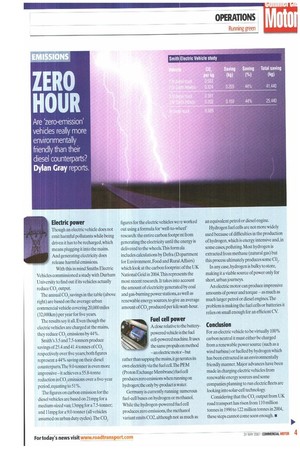ZERO HOUR
Page 49

If you've noticed an error in this article please click here to report it so we can fix it.
Are 'zero-emission' vehicles really more environmentally friendly than their diesel counterparts? Dylan Gray reports
IElectric power Though an electric vehicle does not emit harmful pollutants while being driven it has to be recharged, which means plugging it into the mains. And generating electricity does release harmful emissions With this in mind Smiths Electric Vehicles commissioned a study with Durham University to find out if its vehicles actually reduce CO, output.
The annual CO, savings in the table (above right) are based on the average urban commercial vehicle covering 20,000 miles (32,000Iun) per year for five years The results say it all. Even though the electric vehicles are charged at the mains, they reduce CO, emissions by 44%.
Smith's 3.5 and 7.5-tonners produce savings of 25.4 and 41.4 tonnes of CO, respectively over five years; both figures represent a 44% saving on their diesel cownerparts.The 9.0-tonner is even more impressive — it achieves a 55.8-tonne reduction in CO, emissions over a five-year period,equating to 51%.
The figures on carbon emission for the diesel vehicles are based on 21mpg for a medium-sized van;l3mpg for a 7.5-tonner; and 11mpg for a 9.0-tonner (all vehicles assumed on urban duty cycles). The CO, figures for the electric vehicles were worked out using a formula for 'well-to-wheel' research: the entire carbon footpr nt from generating the electricity until the energy is delivered to the wheels.This form Jla includes calculations by Defra (D vartment for Environment, Food and Rural Affairs) which look at the carbon footprint of the UK National Grid in 2004.This represents the most recent research. It takes into account the amount of electricity generated by coal and gas-burning power stations, a swell as renewable energy sources, to give an average amount of CO, produced per kilowatt-hour.
Fuel cell power
A close relative to the batterypowered vehicle is the fuel cell-powered machine. It uses the same propuls:onmethod —an electric motor —but rather than sapping the mains,it generates its own electricity via the fuel cell.The PEIV1 (Proton Exchange Membrane) fuel cell produces zero emissions when running on hydrogen; the only by-product is water.
Germany is currently running iumerous fuel-cell buses on hydrogen or methanol. While the hydrogen-powered fuel cell produces zero emissions,the methanol variant emits CO2, although not as much as an equivalent petrol or diesel engine.
Hydrogen fuel cells are not more widely used because of difficulties in the production of hydrogen, which is energy intensive and, in some cases, polluting. Most hydrogen is extracted from methane (natural gas) but this process ultimately produces some CO,.
In any case, hydrogen is bulky to store, making it a viable source of power only for short, urban journeys.
An electric motor can produce impressive amounts of power and torque —as much as much larger petrol or diesel engines.lbe problem is making the fuel cells or batteries it relies on small enough for an efficient CV.
Conclusion
For an electric vehicle to be virtually 100% carbon neutral it must either he charged from a renewable power source (such as a wind turbine) or fuelled by hydrogen which has been extracted in an environmentally friendly manner. Major advances have been made in charging electric vehicles from renewable energy sources and some companies planning to run electric fleets are looking into solar-cell technology.
Considering that the CO., output from UK road transport has risen from 110 million tonnes in 1990 to 122 million tonnes in 2004, these steps cannot come soon enough. is






















































































































































































